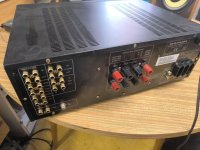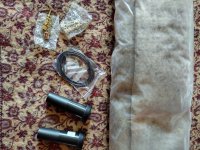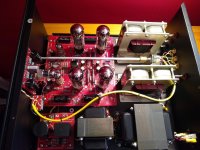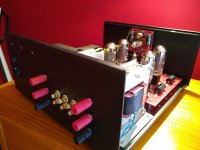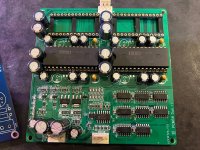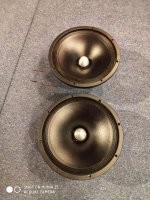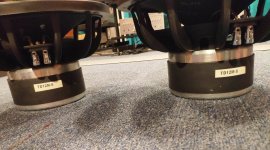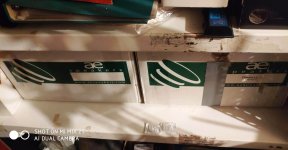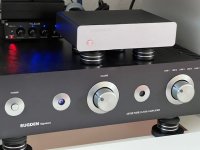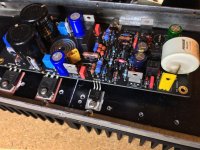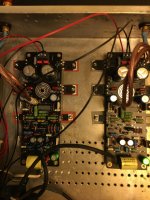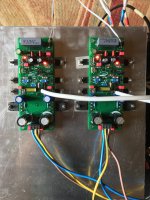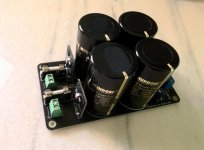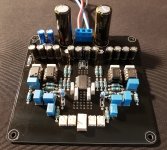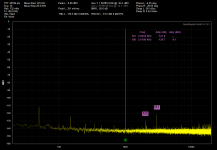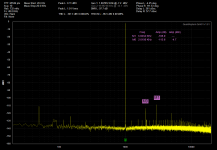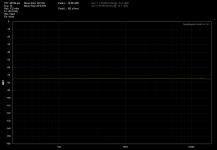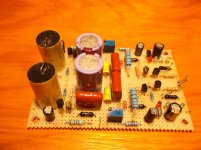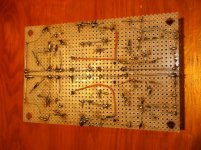After blowing them up after a day of full volume...
Across nearly seven years of... " Oh F.F.S, when I'm I gonna get
those on the bench and fixed ?! ".
Looking deeper into what Peter Walker had originally designed...
The goal:
Rock solid reliability, 20Hz to 20Khz. Match two 303's,
Utilising the best developments in componentry available to me.
Semi conductors were revised, updated where required, along with capacitors. Front panel connections updated.
I didn't get images of both amps complete, or the main heatsink transistor refit- too busy doing it!
Matching the resistors in all four modules was not completed, another time- along with a paint job and new front panel.
I would have probably gone for Takman carbons. Maybe Vishay Dale RN60D/65D metal films in the input driver stage.
Best manual download: search using: Quad-303-Illustrated-Service-Supplement.pdf
Transistor Outline types
https://eesemi.com/to-types.htm
I've tried to find the best resolution, most up to date images of the old manuals. Numbering is on the image jpg:
After several iterations:
The input line sensitivity was increased to 1.5V the circuits design max, before interfering with feedback.
C100 increased to 1uF (.68uF limited the lower frequency range to 30Hz due to the result of the overall limitations of components of the 1970's),
lowering the frequency range handling. Using the highest quality PP Film cap available; MKP1839.
Increasing speaker output caps capacitance for similar reasons.
Looking closely to the Hfe of transistors, their gain structure throughout the input driver circuit and for low noise versions/ shielding.
These are in my opinion the best transistor replacements for the 303, old and new.
The (BCxxx) below are listed on the net for the 303, but IMO have too much gain or can't be easily sourced.
Presenting the new list of components for the 303 Power amplifier:
Quantity per PCB amp per module:
TR104 1 x BC556B T.O.92
TR102/ TR103 2 x BC546B T.O.92
TR101 1 x BC109 T.O.18; lower noise shielding / TR107 1 x BC184B (or K) T.O.92; better stability for TR107. 2 x BC184B fine also. (BC550C)
TR100 1 x BC560B T.O.92 Original design Hfe, 'A' versions available, worked fine (BC214C unobtainable)
TR106 1 x 2N5320 T.O.5 Metal shielding, better vibration resistance when heat sunk. Also MJE182G T.O.126
TR105 1 x 2N5322 T.O.5 Metal shielding, better vibration resistance when heat sunk. Also MJE172G T.O.126
The bias trimmer can be 1K along with a change of R132 to 2K4.
Those bourns 3296Y top adjust 25Turn trimmers are good, more stability.
Quantity per main heatsink:
All T.O.3
TR1 TR2 4 x MJ150003G. Legendary power transistors 250W; 20A per device! The originals are 117W.
TR3 1 x MJ21194G regulator
Quantity per PCB PSU module
TR200 1 x BC556 T.O.92
TR201 1 x MJE 182G 3A T.O.126. Or MJE243 4A. Not BC441
TR3 see heatsink
All diodes 4 x 1N4148
MR201 BZX79-C3V and BZX79-C9V1 connected in series, cancelling temperature gradients- voltage stabilisation results.
The PSU bridge rectifier array has the super quiet NXP BYV29X 600 diodes. They required new heatsinks.
Caps:
Cornell-Dubilier CD15 silver mica
Panasonic FM/ FR electrolytics
Wima MKS4 P.E.T
MKP1839 Polyprops
Electrolytic 'T' network capacitor
T-power BHC Aerovox ALN20S1108DF now Kemet. Rated to 100V,
Only one required, uprate to 10,000uF with noise suppressing MKS4,
On a single rail PSU connect the negative through both pins.
Speaker Output caps:
Kemet BHC slitfoils ALP20S1009DD 10,000µF 50 Vdc
Add noise suppression on cap pins, again MKS4.
---
PSU board increase the 6.8K to 10K
The only other genuine improvement that I didn't get around to was the use of two semiconductor current sources,
in place of R112 and R117 to improve noise and bias stability. Class D regulators i think.
If someone else figures that out, please post it here so there is a definitive list.
The 'before' images.
The 'after' images:
Words after the refit?
Alive. Engaging. Open. Seismic.
It's like a heavy cloth has been removed from the speakers.









